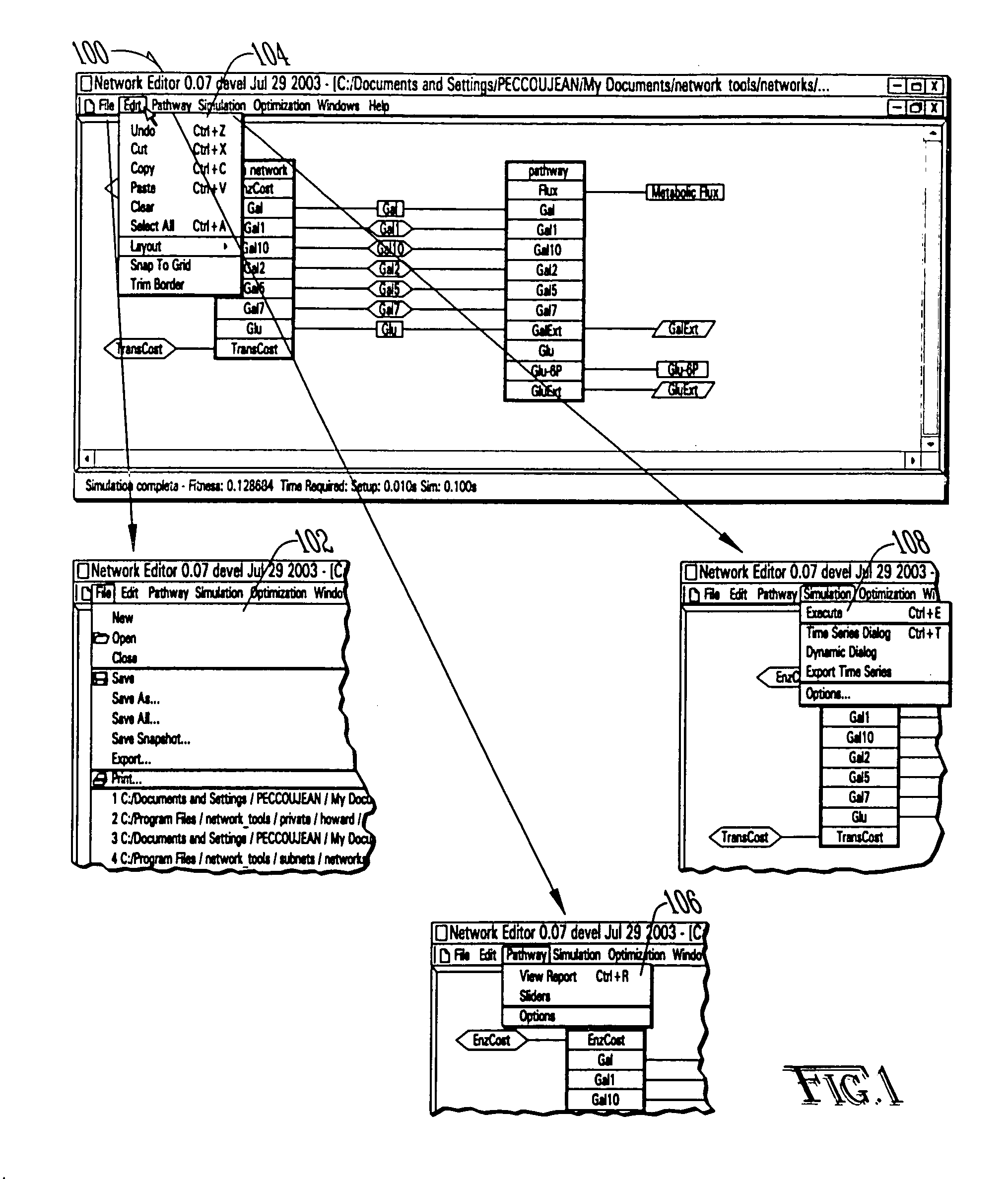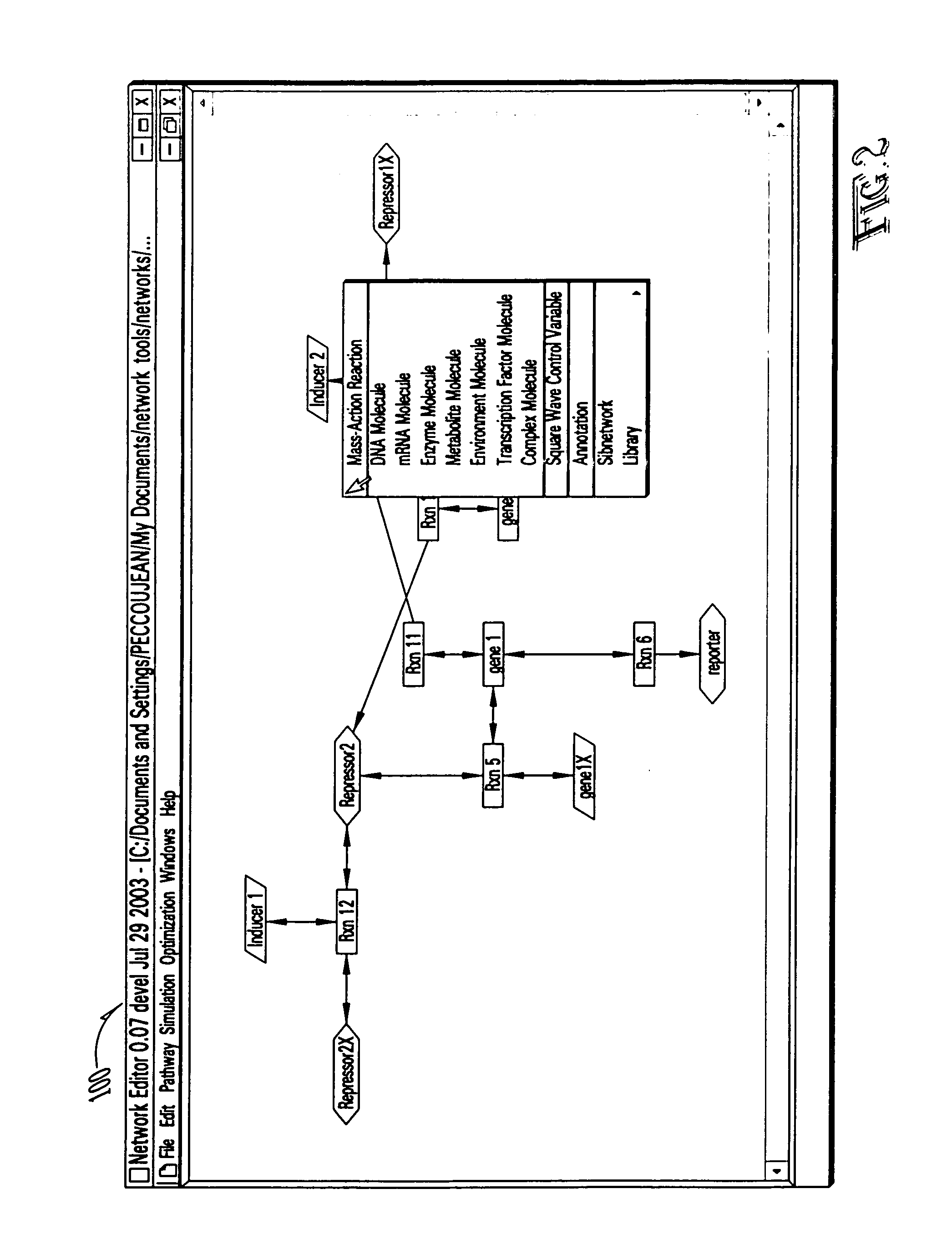Computer systems and methods for genotype to phenotype mapping using molecular network models
a computer system and network model technology, applied in the field of molecular network models, can solve the problems of inability to account for nonlinear gene to gene interaction in models, the challenge of bridging molecular biology as well as genomics or proteomics, and the nontrivial nature of the older sciences of biology, medicine, and genetics, etc., to determine the environmental effect of phenotypic development of a genotyp
- Summary
- Abstract
- Description
- Claims
- Application Information
AI Technical Summary
Benefits of technology
Problems solved by technology
Method used
Image
Examples
code example 1
A Code Segment in C Implementing Differential Equations Representing Network Dynamics
[0131] f(integer N, real t, N_Vector Y, N_Vector Y2, void*f_data){const double*KC=(double*)f_data; [0132] double r0=KC[1]*N_VIth(Y, 0); [0133] double r1=KC[1]*N_VIth(Y, 0)*N_VIth(Y, 11); [0134] double r2=KC[2]*N_VIth(Y, 1)*N_VIth(Y, 11); [0135] double r3=KC[3]*N_VIth(Y, 2); [0136] double r4=KC[4]*N_VIth(Y, 8)*N_VIth(Y, 9); [0137] double r5=KC[5]*N_VIth(Y, 10); [0138] double r6=KC[6]*N_VIth(Y, 9); [0139] double r7=KC[7]*N_VIth(Y, 4)*N_VIth(Y, 12); [0140] double r8=KC[8]*N_VIth(Y, 13); [0141] double r9=KC[9]*N_VIth(Y)*N_VIth(Y, 13); [0142] double r10=KC[10]*N_VIth(Y, 6); [0143] double r11=KC[11]*N_VIth(Y, 6)*N_VIth(Y, 15); [0144] double r12=KC[12]*N_VIth(Y, 7); [0145] double r13=KC[13]*N_VIth(Y, 13); [0146] double r14=KC[14]*N_VIth(Y, 13); [0147] double r15=KC[15]*N_VIth(Y, 7); [0148] double r16=KC[16]*N_VIth(Y, 7); [0149] double r17=KC[17]*N_VIth(Y, 7); [0150] double r18=KC[18]*N_VIth(Y, 13); [0151]...
code example 2
A Code Segment in MATLAB Implementing Differential Equations Representing Network Dynamics
[0174] r1=KC(1)*Y(1); [0175] r2=KC(2)*Y(1)*Y(12); [0176] r3=KC(3)*Y(2)*Y(12); [0177] r4=KC(4)*Y(3); [0178] r5=KC(5)*Y(9)*Y(10); [0179] r6=KC(6)*Y(11); [0180] r7=KC(7)*Y(10); [0181] r8=KC(8)*Y(5)*Y(13); [0182] r9=KC(9)*Y(14); [0183] r10=KC(10)*Y(4)*Y(14); [0184] r11=KC(11)*Y(7); [0185] r12=KC(12)*Y(7)*Y(16); [0186] r13=KC(13)*Y(8); [0187] r14=KC(14)*Y(14); [0188] r15=KC(15)*Y(14); [0189] r16=KC(16)*Y(8); [0190] r17=KC(17)*Y(8); [0191] r18=KC(18)*Y(8); [0192] r19=KC(19)*Y(14); [0193] r20=KC(20)*Y(15); [0194] r21=KC(21)*Y(9); [0195] r22=KC(22)*Y(5); [0196] r23=KC(23)*Y(4); [0197] r24=KC(24)*Y(6); [0198] r25=KC(25)*Y(12); [0199] r26=KC(26)*Y(2)*Y(6); [0200] r27=KC(27)*Y(16); [0201] Y2=zeros(16, 1); [0202] Y2(2)=1.000000*r1+1.000000*r2+−1.000000*r3; [0203] Y2(3)=1.000000*r3+−1.000000*r4; [0204] Y2(4)=−1.000000*r10+1.000000*r11+1.000000*r14+1.000000*r16+−1.000000*r23; [0205] Y2(5)=1.000000*r7+−1.000...
code example 3
A Code Segment in C Implementing Trait Functions
[0216] A trait value may be defined for the simulated phenotype in the GP mapping system according to one embodiment. Below is an exemplary code segment that implements in C a number of trait functions defined for the molecular network of the yeast galactose genetic switch as well as a generic trait function based on root mean squared deviation from provided experimental measurements. See also, U.S. Provisional Application No. 60 / 499,955, filed Sep. 2, 2003 and U.S. Provisional Application No. 60 / 499,786 filed Sep. 2, 2003.
boolFitness::calculate (PathwayMatrix &pem, double &fitness, Matrix &mat) { fitness = 0.0; if(ff— == 0) {} else if(ff— == 1) { int i, j; int ne = targets_.ncolumns( ); int nm = targets_.nrows( ); if(pem.simulation.numEnvironment( ) != ne) { pneDebug(“pem.simulation.numEnvironment( ) != ne”); return false; }IMatrix inds(nm, 1);for(i=0; i inds(i, 0) = pem.moleculeLookup(molecules_[i]); if(inds(i, 0) == −1) ...
PUM
 Login to View More
Login to View More Abstract
Description
Claims
Application Information
 Login to View More
Login to View More - R&D
- Intellectual Property
- Life Sciences
- Materials
- Tech Scout
- Unparalleled Data Quality
- Higher Quality Content
- 60% Fewer Hallucinations
Browse by: Latest US Patents, China's latest patents, Technical Efficacy Thesaurus, Application Domain, Technology Topic, Popular Technical Reports.
© 2025 PatSnap. All rights reserved.Legal|Privacy policy|Modern Slavery Act Transparency Statement|Sitemap|About US| Contact US: help@patsnap.com



